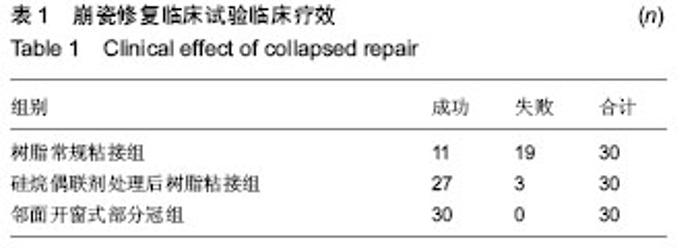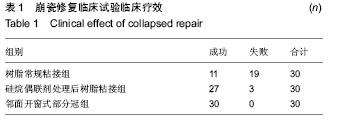Chinese Journal of Tissue Engineering Research ›› 2015, Vol. 19 ›› Issue (34): 5433-5437.doi: 10.3969/j.issn.2095-4344.2015.34.005
Previous Articles Next Articles
Clinical trial of collapsed repair and in vitro tensile strength test
Wang Xing1, Qi Lu2, Gu Zhen-yu3, He Hui-yu1
- 1Department of Prosthodontics, First Affiliated Hospital of Xinjiang Medical University, Urumqi 830054, Xinjiang Uygur Autonomous Region, China; Department of Stomatology, Second Affiliated Hospital of Xinjiang Medical University, Urumqi 830063, Xinjiang Uygur Autonomous Region, China; 3Department of Stomatology, Hospital of Xinjiang Production & Construction Corps, Urumqi 830011, Xinjiang Uygur Autonomous Region, China
-
Online:2015-08-20Published:2015-08-20 -
About author:Wang Xing, Master, Attending physician, Department of Prosthodontics, First Affiliated Hospital of Xinjiang Medical University, Urumqi 830054, Xinjiang Uygur Autonomous Region, China
CLC Number:
Cite this article
Wang Xing, Qi Lu, Gu Zhen-yu, He Hui-yu. Clinical trial of collapsed repair and in vitro tensile strength test [J]. Chinese Journal of Tissue Engineering Research, 2015, 19(34): 5433-5437.
share this article
| [1] 董定锋,孙强.金属面钉洞联合瓷聚合体树脂修复前牙烤瓷冠崩瓷[J].实用医药杂志,2014,31(9):809-810. [2] Matviiv YY,Simakovych OH.Dislocation mechanisms of micro-cracking A sarvey.Mater Sci.2013;48(6):776-787. [3] 杜倩,周敏波,张新平,等.前牙全瓷冠饰瓷崩裂断口形貌分析[J].中华口腔医学杂志,2012,47(4):225-228. [4] 蔚劲涛,张少锋,高婧,等.4247件氧化锆全瓷修复体临床疗效的回顾性研究[J].牙体牙髓牙周病学杂志,2014,24(4):226-230. [5] 刘洋,李振春,陈小冬.Cercon CAD/CAM后牙氧化锆全瓷冠桥16例崩瓷原因分析[J].中国实用口腔科杂志,2010,3(6):369-370. [6] 杨获烽,刘则玉.13例氧化锆全瓷冠桥修复体瓷层崩脱原因分析[J].国际医药卫生导报,2011,17(12):1426-1428. [7] 李保泉,刘晓秋,郭晓东,等.金属烤瓷修复体瓷裂或瓷崩的原因分析[J].中外健康文摘, 2010,7(31):366-366. [8] 王小芳,刘宇飞.PFM崩瓷原因分析与对策[J].中国医学创新, 2010,7(24):180-181. [9] 邢民.金属烤瓷修复体崩瓷的原因分析和处理[J].中国美容学, 2010,19(4):69. [10] 葛峰,李保泉.磨牙区金属烤瓷修复体瓷裂或瓷崩的原因分析[J].中国医药指南, 2011,9(27):216-217. [11] 刘艳红.1例二氧化锆修复病例崩瓷引起的反思[J].中国伤残医学, 2013,21(2):219. [12] 肖凌,巢永烈.氧化锆全瓷修复体崩瓷的主要原因探讨[J].国际口腔医学杂志,2013,40(2): 195-198. [13] 王小芳,刘宇飞.PFM崩瓷原因分析与对策[J].中国医学创新, 2010,7(24):180-181. [14] 刘洋,李振春,陈小冬.Cercon CAD/CAM后牙氧化锆全瓷冠桥16例崩瓷原因分析[J].中国实用口腔科杂志,2010,3(6):369-370. [15] 郭鹏.45例金属烤瓷冠修复失败原因分析[J].中国实用医药, 2011,6(31):75-76. [16] 陈娜,刘敏.氧化锆全瓷修复体崩瓷原因分析[J].西南医学,2015, 17(2):221-223. [17] 常红风.45例烤瓷牙崩瓷现象的预防和治疗[J].中国社区医师, 2010,12(9):84-85. [18] 古海霞.金属烤瓷冠崩瓷89例处理分析[J].中国误诊学杂志, 2010, 10(31):7716-7716. [19] 梁琦琪.金瓷修复体崩瓷原因探讨及崩瓷修补方法[J].现代中西医结合杂志,2010,19(6): 710-711. [20] 薛玉萍.金属烤瓷修复体瓷崩裂的原因分析及对策[J].中外健康文摘,2012,9(48):235-236. [21] 王庆寅.PFM冠崩瓷的临床解决方案探讨[J].中外健康文摘, 2012,9(28):431-432. [22] 王征,苏江宁.烤瓷牙崩瓷不拆冠修复术47例临床观察[J].医学临床研究,2012,29(7):1378-1379. [23] 金秀英,祝焕明,周怡.前牙区金属烤瓷桥崩瓷的金属烤瓷插片修复[J].浙江临床医学, 2014,16(5):774-775. [24] 杨安琼.金瓷修复体崩瓷原因探讨及崩瓷修补方法[J].中国卫生产业,2014,11(23):160-161. [25] 孟小睿,王晶.Super Bond C&B应用于后牙金属烤瓷修复体大面积崩瓷的临床疗效研究[J].中国医疗前沿,2011,23(6):51. [26] 张敏,郑苍尚.Vivadent瓷修补系统修复金瓷修复体崩瓷临床研究[J].中华实用诊断与治疗杂志,2013,27(8):767-768. [27] 徐秋艳,张军梅,刘曙.复合树脂修补贵金属烤瓷冠崩瓷的临床疗效[J].贵阳医学院学报,2011,36(2):190-191. [28] 慕宗秩,张力.邻面开口式部分烤瓷冠修复固定桥崩瓷方法探讨[J].中国美容医学,2012,21(14):36-37. [29] 殷家悦,包扬,艾红军等.不同表面处理方式对氧化锆基全瓷崩瓷树脂修补剪切强度的影响[J].口腔医学研究,2009,25(5): 629-631. |
| [1] | Chen Ziyang, Pu Rui, Deng Shuang, Yuan Lingyan. Regulatory effect of exosomes on exercise-mediated insulin resistance diseases [J]. Chinese Journal of Tissue Engineering Research, 2021, 25(25): 4089-4094. |
| [2] | Chen Yang, Huang Denggao, Gao Yuanhui, Wang Shunlan, Cao Hui, Zheng Linlin, He Haowei, Luo Siqin, Xiao Jingchuan, Zhang Yingai, Zhang Shufang. Low-intensity pulsed ultrasound promotes the proliferation and adhesion of human adipose-derived mesenchymal stem cells [J]. Chinese Journal of Tissue Engineering Research, 2021, 25(25): 3949-3955. |
| [3] | Yang Junhui, Luo Jinli, Yuan Xiaoping. Effects of human growth hormone on proliferation and osteogenic differentiation of human periodontal ligament stem cells [J]. Chinese Journal of Tissue Engineering Research, 2021, 25(25): 3956-3961. |
| [4] | Sun Jianwei, Yang Xinming, Zhang Ying. Effect of montelukast combined with bone marrow mesenchymal stem cell transplantation on spinal cord injury in rat models [J]. Chinese Journal of Tissue Engineering Research, 2021, 25(25): 3962-3969. |
| [5] | Gao Shan, Huang Dongjing, Hong Haiman, Jia Jingqiao, Meng Fei. Comparison on the curative effect of human placenta-derived mesenchymal stem cells and induced islet-like cells in gestational diabetes mellitus rats [J]. Chinese Journal of Tissue Engineering Research, 2021, 25(25): 3981-3987. |
| [6] | Hao Xiaona, Zhang Yingjie, Li Yuyun, Xu Tao. Bone marrow mesenchymal stem cells overexpressing prolyl oligopeptidase on the repair of liver fibrosis in rat models [J]. Chinese Journal of Tissue Engineering Research, 2021, 25(25): 3988-3993. |
| [7] | Liu Jianyou, Jia Zhongwei, Niu Jiawei, Cao Xinjie, Zhang Dong, Wei Jie. A new method for measuring the anteversion angle of the femoral neck by constructing the three-dimensional digital model of the femur [J]. Chinese Journal of Tissue Engineering Research, 2021, 25(24): 3779-3783. |
| [8] | Meng Lingjie, Qian Hui, Sheng Xiaolei, Lu Jianfeng, Huang Jianping, Qi Liangang, Liu Zongbao. Application of three-dimensional printing technology combined with bone cement in minimally invasive treatment of the collapsed Sanders III type of calcaneal fractures [J]. Chinese Journal of Tissue Engineering Research, 2021, 25(24): 3784-3789. |
| [9] | Qian Xuankun, Huang Hefei, Wu Chengcong, Liu Keting, Ou Hua, Zhang Jinpeng, Ren Jing, Wan Jianshan. Computer-assisted navigation combined with minimally invasive transforaminal lumbar interbody fusion for lumbar spondylolisthesis [J]. Chinese Journal of Tissue Engineering Research, 2021, 25(24): 3790-3795. |
| [10] | Hu Jing, Xiang Yang, Ye Chuan, Han Ziji. Three-dimensional printing assisted screw placement and freehand pedicle screw fixation in the treatment of thoracolumbar fractures: 1-year follow-up [J]. Chinese Journal of Tissue Engineering Research, 2021, 25(24): 3804-3809. |
| [11] | Shu Qihang, Liao Yijia, Xue Jingbo, Yan Yiguo, Wang Cheng. Three-dimensional finite element analysis of a new three-dimensional printed porous fusion cage for cervical vertebra [J]. Chinese Journal of Tissue Engineering Research, 2021, 25(24): 3810-3815. |
| [12] | Wang Yihan, Li Yang, Zhang Ling, Zhang Rui, Xu Ruida, Han Xiaofeng, Cheng Guangqi, Wang Weil. Application of three-dimensional visualization technology for digital orthopedics in the reduction and fixation of intertrochanteric fracture [J]. Chinese Journal of Tissue Engineering Research, 2021, 25(24): 3816-3820. |
| [13] | Sun Maji, Wang Qiuan, Zhang Xingchen, Guo Chong, Yuan Feng, Guo Kaijin. Development and biomechanical analysis of a new anterior cervical pedicle screw fixation system [J]. Chinese Journal of Tissue Engineering Research, 2021, 25(24): 3821-3825. |
| [14] | Lin Wang, Wang Yingying, Guo Weizhong, Yuan Cuihua, Xu Shenggui, Zhang Shenshen, Lin Chengshou. Adopting expanded lateral approach to enhance the mechanical stability and knee function for treating posterolateral column fracture of tibial plateau [J]. Chinese Journal of Tissue Engineering Research, 2021, 25(24): 3826-3827. |
| [15] | Zhu Yun, Chen Yu, Qiu Hao, Liu Dun, Jin Guorong, Chen Shimou, Weng Zheng. Finite element analysis for treatment of osteoporotic femoral fracture with far cortical locking screw [J]. Chinese Journal of Tissue Engineering Research, 2021, 25(24): 3832-3837. |
| Viewed | ||||||
|
Full text |
|
|||||
|
Abstract |
|
|||||

